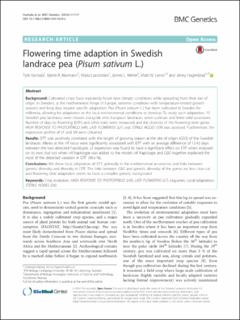| dc.contributor.author | Vanhala, Tytti | |
| dc.contributor.author | Normann, Kjersti Ringvoll | |
| dc.contributor.author | Lundström, Maria | |
| dc.contributor.author | Weller, James L | |
| dc.contributor.author | Leino, Matti W | |
| dc.contributor.author | Hagenblad, Jenny | |
| dc.date.accessioned | 2020-03-24T13:02:44Z | |
| dc.date.available | 2020-03-24T13:02:44Z | |
| dc.date.created | 2017-02-06T11:01:36Z | |
| dc.date.issued | 2016 | |
| dc.identifier.citation | BMC Genetics. 2016, 17 (117), . | en_US |
| dc.identifier.issn | 1471-2156 | |
| dc.identifier.uri | https://hdl.handle.net/11250/2648369 | |
| dc.description.abstract | Background
Cultivated crops have repeatedly faced new climatic conditions while spreading from their site of origin. In Sweden, at the northernmost fringe of Europe, extreme conditions with temperature-limited growth seasons and long days require specific adaptation. Pea (Pisum sativum L.) has been cultivated in Sweden for millennia, allowing for adaptation to the local environmental conditions to develop. To study such adaptation, 15 Swedish pea landraces were chosen alongside nine European landraces, seven cultivars and three wild accessions. Number of days to flowering (DTF) and other traits were measured and the diversity of the flowering time genes HIGH RESPONSE TO PHOTOPERIOD (HR), LATE FLOWERING (LF) and STERILE NODES (SN) was assessed. Furthermore, the expression profiles of LF and SN were obtained.
Results
DTF was positively correlated with the length of growing season at the site of origin (GSO) of the Swedish landraces. Alleles at the HR locus were significantly associated with DTF with an average difference of 15.43 days between the two detected haplotypes. LF expression was found to have a significant effect on DTF when analysed on its own, but not when HR haplotype was added to the model. HR haplotype and GSO together explained the most of the detected variation in DTF (49.6 %).
Conclusions
We show local adaptation of DTF, primarily in the northernmost accessions, and links between genetic diversity and diversity in DTF. The links between GSO and genetic diversity of the genes are less clear-cut and flowering time adaptation seems to have a complex genetic background. | en_US |
| dc.language.iso | eng | en_US |
| dc.publisher | BMC | en_US |
| dc.rights | Navngivelse 4.0 Internasjonal | * |
| dc.rights.uri | http://creativecommons.org/licenses/by/4.0/deed.no | * |
| dc.title | Flowering time adaption in Swedish landrace pea (Pisum sativum L.) | en_US |
| dc.type | Peer reviewed | en_US |
| dc.type | Journal article | en_US |
| dc.description.version | publishedVersion | en_US |
| dc.source.pagenumber | 13 | en_US |
| dc.source.volume | 17 | en_US |
| dc.source.journal | BMC Genetics | en_US |
| dc.source.issue | 117 | en_US |
| dc.identifier.doi | 10.1186/s12863-016-0424-z | |
| dc.identifier.cristin | 1447292 | |
| dc.description.localcode | © 2016 The Author(s).Open Access. This article is distributed under the terms of the Creative Commons Attribution 4.0International License (http://creativecommons.org/licenses/by/4.0/), which permits unrestricted use, distribution, andreproduction in any medium, provided you give appropriate credit to the original author(s) and the source, provide a link tothe Creative Commons license, and indicate if changes were made. The Creative Commons Public Domain Dedication waiver(http://creativecommons.org/publicdomain/zero/1.0/) applies to the data made available in this article, unless otherwise stated. | en_US |
| cristin.ispublished | true | |
| cristin.fulltext | original | |
| cristin.qualitycode | 1 | |

